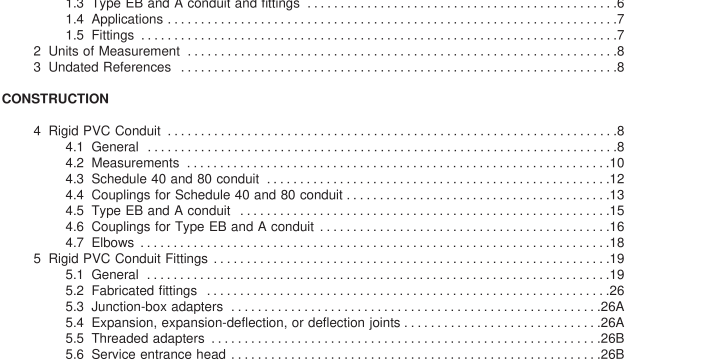UL 651-2011 pdf download.Schedule 40, 80, Type EB and A Rigid PVC Conduit and Fittings.
1.2 Schedule 40 and 80 conduit and fittings 1 .2.1 Schedule 40 rigid PVC conduit and fittings are for aboveground use indoors or outdoors exposed to sunlight and weather, and for underground use by direct burial or encasement in concrete. Schedule 40 rigid PVC conduit, elbows, that are specifically marked for underground use are suitable for use underground only by direct burial or encasement in concrete. 1 .2.2 Schedule 80 rigid PVC conduit and fittings are for use wherever Schedule 40 rigid PVC conduit may be used and are for installation on poles in accordance with the National Electrical Code (NEC), NFPA 70. 1 .2.3 The following restrictions apply to use of the Schedule 40 and Schedule 80 rigid PVC conduit and fittings mentioned in 1 .1 .1 : a) Use at 50°C (1 22°F) and lower ambient temperatures and b) Use with 75°C (1 67°F) wiring, but the conduit and fittings may be used with 90°C (1 94°F) wiring if they comply with the construction (see Conduit for Use with 90°C Wire, 6.1 5) and marking (see 8.2.1 , 8.2.4 and 8.2.5) requirements covering use with 90°C (1 94°F) wiring. 1 .2.4 In addition to the applicable requirements specified in this standard, Schedule 40 and Schedule 80 rigid PVC conduit intended for directional boring shall be subjected to the performance requirements in 6.1 2. 1 .2.5 Deleted May 2, 201 4. 1.3 Type EB and A conduit and fittings 1 .3.1 The Type EB and Type A rigid PVC conduit and fittings mentioned in 1 .1 .1 are intended for use at 50°C (1 22°F) and lower ambient temperatures. Type A rigid PVC conduit and fittings are intended for use with 75°C (1 67°F) wiring. Type A and Type EB rigid PVC conduit and fittings, where encased in concrete in trenches outside of buildings, may be used with 90°C (1 94°F) wiring. 1 .3.2 Type EB (encased burial) rigid PVC conduit is intended for encasement in concrete in trenches outside of buildings. Type A rigid PVC conduit is intended for encasement in concrete in any location.
2 Units of Measurement 2.1 Values stated without parentheses are the requirement. Values in parentheses are explanatory or approximate information. 2.2 Unless otherwise indicated, all voltage and current values mentioned in this standard are root-mean-square (rms). 3 Undated References 3.1 Any undated reference to a code or standard appearing in the requirements of this standard shall be interpreted as referring to the latest edition of that code or standard. CONSTRUCTION 4 Rigid PVC Conduit 4.1 General 4.1 .1 The compound of which rigid PVC conduit and fittings are made shall equal or exceed the cell classification 1 21 23 as described in Standard Specification for Rigid Poly (Vinyl Chloride) (PVC) Compounds and Chlorinated Poly (Vinyl Chloride) (CPVC Compounds), ASTM D 1 784. 4.1 .2 Clean rework compound, generated from the manufacturer’s own production and reused by the manufacturer, meets the intent of these requirements when the finished product complies with all of the requirements of this standard. 4.1 .3 Clean industrial scrap (as defined in Standard Guide for Development of ASTM Standards Relating to Recycling and Use of Recycled Plastics, ASTM D 5033) that is not commingled with other plastic materials and originates from a single manufacturing process shall be permitted to be used if: a) Each source has been qualified in accordance with the requirements of the Standard for Polymeric Materials – Fabricated Parts, UL 746D and b) The conduit and fittings produced meet all the requirements of this standard.
4.1 .6 Both ends of each length of rigid PVC conduit shall be perpendicular to the longitudinal axis of the conduit. Exception: An interior chamfer on the spigot end of conduit is not prohibited. The chamfer shall be constructed as shown in Figure 1 of Standard Specification for Smooth-Wall Poly (Vinyl Chloride) (PVC) Conduit and Fittings for Underground Installation, ASTM F 51 2. A chamfered end is not considered to be a taper. 4.1 .7 Rigid PVC conduit and elbows shall not be threaded. There shall not be any taper to the conduit unless one end is formed as an integral coupling. In that case, only the interior surface of the integral coupling may be tapered. 4.1 .8 For specific applications or uses, lengths may be shipped from the factory with or without couplings or with an adapter instead of a coupling. A coupling with a center stop need not be cemented to the conduit when the conduit is shipped but may be separately packaged. 4.1 .9 For general use, a PVC coupling or similar fitting shall be cemented, heat-fused, or molded (see 4.1 .1 0) to one end of each length of conduit before the conduit is shipped from the factory. The coupling or similar fitting shall comply with the requirements concerning reagent resistance in Resistance to Specific Reagents, 7.2.1 0, and 9.2.1 , and 9.2.2 if the conduit to which it is attached complies with the requirements for wetting by or immersion in reagents. If a stopless coupling is used, the end of the conduit shall be within 1 /8 inch (3 mm) of the center of the coupling. UL 651-2011 pdf download.
UL 651-2011 pdf download
